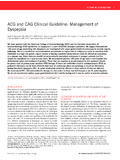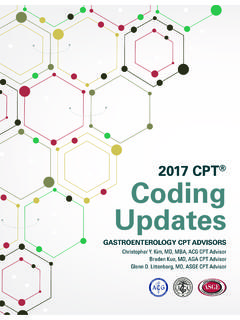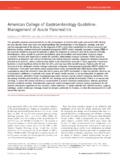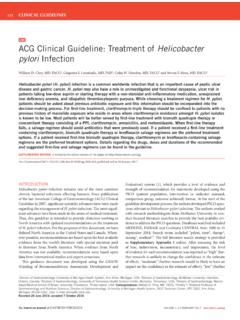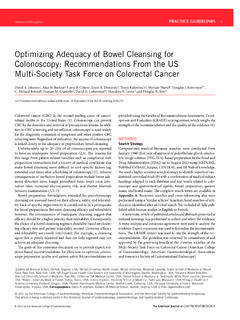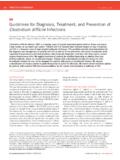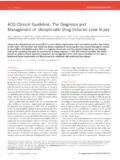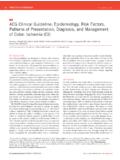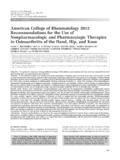Transcription of American College of Gastroenterology Monograph …
1 S2 VOLUME 109 SUPPLEMENT 1 AUGUST 2014 nature publishing group CMErelated editorial on page x see American College of Gastroenterology Monograph on the Management of Irritable Bowel Syndrome and Chronic Idiopathic Constipation Alexander C. Ford, MB ChB, MD, FRCP1,10, Paul Moayyedi, BSc, MB ChB, PhD, MPH, FACG2,11, Brian E. Lacy, MD, PhD, FACG3, Anthony J. Lembo, MD4, Yuri A. Saito, MD, MPH5, Lawrence R. Schiller, MD, FACG6, Edy E. Soffer, MD, FACG7, Brennan Spiegel, MD, FACG8 and Eamonn Quigley, MD, FACG9, for the Task Force on the Management of Functional Bowel Disorders Am J Gastroenterol 2014; 109:S2 S26; Irritable bowel syndrome (IBS) and chronic idiopathic constipa- According to Rome III, IBS is defined on the basis of the pres- tion ((CIC) also referred to as functional constipation) are two ence of: of the most common functional gastrointestinal disorders world- Recurrent abdominal pain or discomfort at least 3 days/month wide.
2 IBS is a global problem, with anywhere from 5 to 15% of the in the past 3 months associated with two or more of the following: general population experiencing symptoms that would satisfy a definition of IBS (1,2). In a systematic review on the global preva- Improvement with defecation lence of IBS, Lovell and Ford (1) documented a pooled prevalence Onset associated with a change in frequency of stool of 11% with all regions of the world suffering from this disorder Onset associated with a change in form (appearance) of stool at similar rates. Given its prevalence, the frequency of symptoms, and their associated debility for many patients and the fact that These criteria should be fulfilled for the past 3 months with IBS typically occurs in younger adulthood, an important period symptom onset at least 6 months before diagnosis (6).
3 For furthering education, embarking on careers, and/or raising Rome III defines functional constipation as: the presence of families, the socioeconomic impact of IBS is considerable. These two or more of the following: indirect medical costs are frequently compounded by the direct medical costs related to additional medical tests and the use of Straining during at least 25% of defecations various medical and nonmedical remedies that may have limited Lumpy or hard stools in at least 25% of defecations impact. CIC is equally common; in another systematic review, Sensation of incomplete evacuation for at least 25% of defeca- Suares and Ford (3) reported a pooled prevalence of 14%, and also tions noted that constipation was more common in females, in older Sensation of anorectal obstruction/blockage for at least 25%.
4 Subjects, and those of lower socioeconomic status (3). Chronic of defecations constipation has also been linked to impaired quality of life (4), Manual maneuvers to facilitate at least 25% of defecations most notably among the elderly (5). ( , digital evacuation, support of the pelvic floor). Neither IBS nor CIC are associated with abnormal radiologic Fewer than three defecations per week or endoscopic abnormalities, nor are they associated with a reliable biomarker; diagnosis currently rests entirely, therefore, Furthermore, loose stools are rarely present without the use on clinical grounds.
5 Although a number of clinical definitions of laxatives and there are insufficient criteria for IBS. Again, these of both IBS and CIC have been proposed, the criteria developed criteria should be fulfilled for the past 3 months with symptom through the Rome process, currently in its third iteration, have onset at least 6 months before diagnosis (6). been those most widely employed in clinical trials and, therefore, In Rome III, IBS is subtyped according to predominant bowel most relevant to any review of the literature on the management habit as IBS with constipation (IBS-C), IBS with diarrhea (IBS-D), of these disorders.
6 Mixed type (IBS-M), and unclassified (IBS-U). The definition of 1. Leeds Gastroenterology Institute, St James's University Hospital, Leeds, UK; 2 Farncombe Family Digestive Health Research Institute, Division of Gastroenterology , McMaster University, Hamilton, Ontario, Canada; 3 Dartmouth-Hitchcock Medical Center, Lebanon, New Hampshire, USA; 4 Harvard Medical School, Beth Israel Deaconess Medical Center, Boston, Massachusetts, USA; 5 Mayo Clinic, Rochester, Minnesota, USA; 6 Baylor University Medical Center, Digestive Health Associates of Texas, Dallas, Texas, USA; 7 Division of Gastroenterology , Keck School of Medicine, University of Southern California, Los Angeles, California, USA.
7 8. UCLA School of Medicine, UCLA/VA Center for Outcomes Research and Education (CORE), Los Angeles, California, USA; 9 Division of Gastroenterology and Hepatology, Houston Methodist Hospital and Weill Cornell Medical College , Houston, Texas, USA; 10 First author on the Monograph , but is not a member of the Task Force; 11 Conducted systematic reviews with the support of Ford, and carried out the technical analyses of the data independent of the Task Force. Correspondence: Eamonn Quigley, MD, FACG, Chief, Division of Gastroenterology & Hepatology, Houston Methodist Hospital and Weill Cornell Medical College , Houston, Texas, USA.
8 E-mail: The American Journal of Gastroenterology VOLUME 109 | SUPPLEMENT 1 | AUGUST 2014 ACG Monograph on IBS and CIC S3. bowel habit type is, in turn, based on the patient's description of with diarrhea, and mixed IBS), as well as assessing adverse events stool form by referring to the Bristol Stool Scale (7). The recogni- with therapies for both IBS and CIC. tion that IBS sufferers segregate into subtypes according to pre- dominant bowel habit, together with research findings suggesting Systematic review methodology that IBS-C and IBS-D may be pathophysiologically distinct entities We evaluated manuscripts that studied adults (aged > 16 years).
9 (8 10), led to the development of therapies specifically directed at using any definition of IBS or CIC. For IBS, this included a cli- each of these subtypes. Nonetheless, it is worth noting that symp- nician-defined diagnosis, the Manning criteria (23), the Kruis toms may not be stable over a lifetime and individuals may exhibit score (24), or Rome I (25), II (26), or III (6) criteria. For CIC, one IBS subtype during a period, and then a different IBS subtype this included symptoms diagnosed by any of the Rome criteria during another period in their lives. (6,25,26), as well as a clinician-defined diagnosis.
10 We included However, although there is general awareness of the Rome only parallel-group randomized controlled trials (RCTs) com- criteria, they are infrequently employed in the assessment of paring active intervention with either placebo or no therapy. IBS and CIC in clinical practice (11). To provide more clinician Crossover trials were eligible for inclusion, provided extractable friendly definitions, as well as to permit inclusion of studies data were provided at the end of the first treatment period, before that predated the Rome process, American College of Gastro- crossover.
